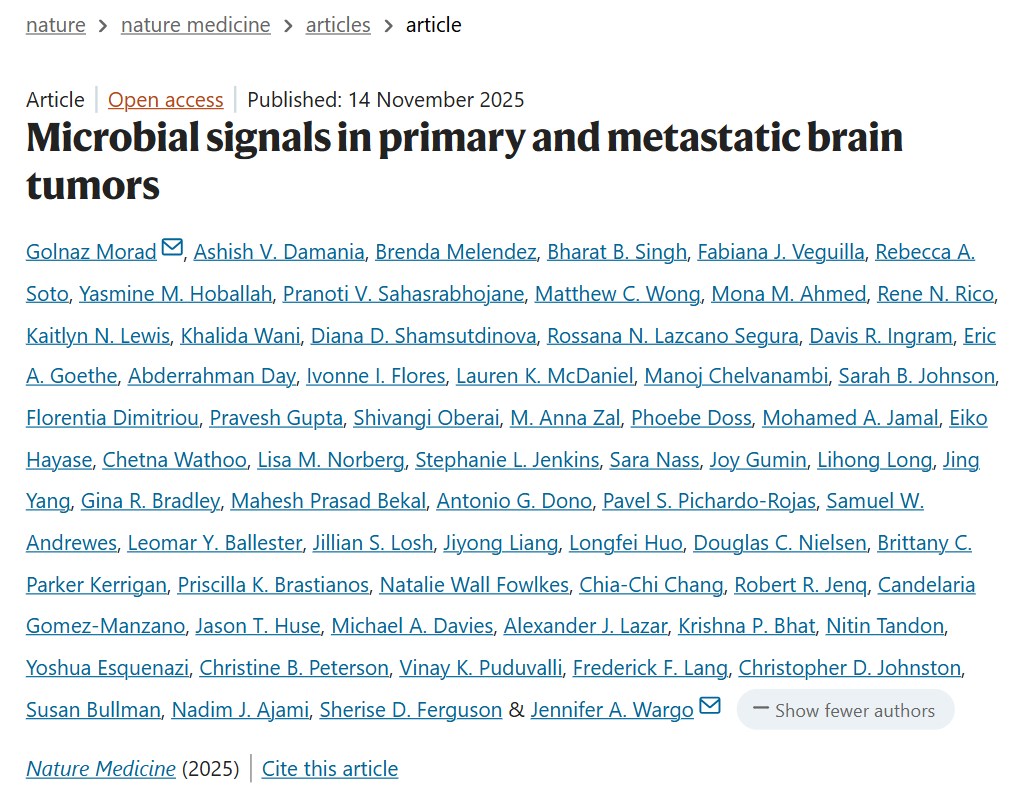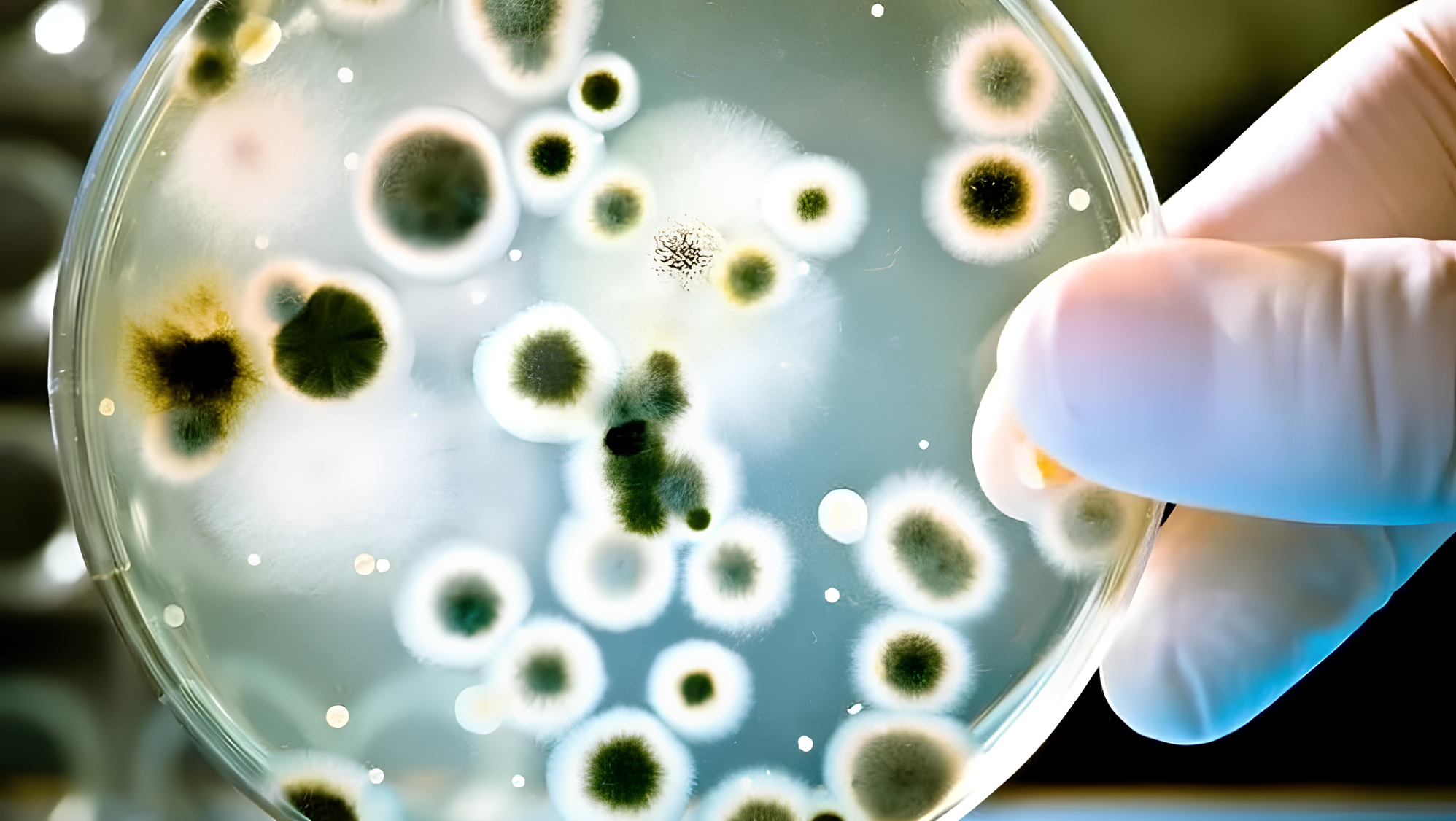Traces of bacteria inside brain tumors may affect tumor behavior
- Researchers found bacterial genetic and cellular elements inside brain tumor cells that appear biologically active and may influence tumor progression and treatment outcomes
- These bacterial elements were also found to be linked to specific immune and metabolic responses in brain tumors
- Outcomes for glioma and other brain tumor patients remain poor, underscoring the need for better treatments, which these findings may help advance
Researchers at The University of Texas MD Anderson Cancer Center have uncovered unexpected traces of bacteria within brain tumors. This discovery offers new insights into the environment in which brain tumors grow and sets the stage for future studies seeking to improve treatment outcomes.
Published today in Nature Medicine, the data revealed that bacterial genetic and cellular elements were present inside brain tumor cells and across the tumor microenvironment. These bacterial components appeared biologically active, potentially influencing tumor behavior and progression in patients with gliomas and brain metastases.
The multi-institutional study was led by Golnaz Morad, D.D.S, Ph.D., postdoctoral research fellow in Surgical Oncology, and Jennifer Wargo, M.D., professor of Surgical Oncology and Genomic Medicine and core member of the James P. Allison Institute – working in close collaboration with MD Anderson’s Platform for Innovative Microbiome and Translational Research (PRIME-TR).
“This work opens a new dimension in our understanding of brain tumor biology. By mapping how microbial elements influence the brain tumor microenvironment, we may be able to identify new therapeutic strategies to improve outcomes for patients facing these devastating diseases,” Wargo said.

Why is it important to understand the microbes present in brain tumors?
Gliomas and brain metastases are associated with poor outcomes, suggesting a deeper understanding of brain tumor biology is necessary to improve treatment responses.
Although there is solid evidence regarding the presence of intra-tumoral microbes in gastrointestinal cancers such as colorectal cancer, there is debate as to whether these microbes are genuinely present universally in all types of tumors.
This study is the largest to date to explore bacterial elements in brain tumors and provides evidence, for the first time, that bacterial elements can be detected within cells in brain tumors. This is particularly important because the brain has historically been considered a sterile environment and, as a result, brain tumors were thought to be free of bacterial elements.
“These findings highlight a previously unknown player in the brain tumor microenvironment – a new piece of the puzzle that may help explain brain tumor behavior. Bacterial elements appear to interact with immune cells within the tumor in ways that could influence how tumors develop and respond to treatment,” Morad said.

What are the other key findings of this study?
Researchers analyzed more than 200 brain tissue samples using multiple advanced methods, including detailed imaging, genetic sequencing, and bacterial culture to detect and examine the nature of bacterial elements in brain tumors.
In addition to the main finding, this study further showed that these bacterial elements were associated with distinct tumor behavior, specifically certain antimicrobial and immune-metabolic pathways within tumors. Bioinformatic analyses also suggested connections between intra-tumoral bacterial elements and distinct microbial communities in the body, particularly the oral microbiome (i.e. bacteria residing in the oral cavity).
What comes next in understanding how bacterial elements influence brain tumors?
Expanding on this research, experts are now working to better understand how bacterial components might reach the brain and influence the growth or behavior of brain tumors. They are also investigating whether certain conditions, such as gum disease or side effects from cancer treatments like chemotherapy and radiotherapy, could play a role in this process. By building on these findings, scientists aim to use this knowledge to develop new and improved treatment approaches for patients with brain tumors.
What are the limitations of this study?
The correlative nature of this clinical study did not allow the researchers to say for certain whether the bacterial elements cause clinically meaningful changes in the tumors. In addition, oral, gut, and tumor bacteria can vary depending on where people live, their environment, and their lifestyle. As a result, the types of bacteria identified in brain tumors in this study should be confirmed in larger and more diverse groups of people.
This study was supported by MD Anderson institutional funds, including the Andrew M. McDougall Brain Metastasis Clinic and Research Program and the Strategic Research Initiative Development (STRIDE) Program. Additional funding support includes the National Institutes of Health/National Cancer Institute (F32 CA260769), the NIH/National Institute of Neurological Disorders and Stroke (R21 NS130323), the Dr. Marnie Rose Foundation, and the Stand Up to Cancer Convergence Grant. For a full list of collaborating authors, disclosures, and funding sources, read the full paper in Nature Medicine.
Title: Microbial signals in primary and metastatic brain tumors
Authors: Golnaz Morad, Ashish V. Damania, Brenda Melendez, Bharat B. Singh, Fabiana J. Veguilla, Rebecca A. Soto, Yasmine M. Hoballah, Pranoti V. Sahasrabhojane, Matthew C. Wong, Mona M. Ahmed, Rene N. Rico, Kaitlyn N. Lewis, Khalida Wani, Diana D. Shamsutdinova, Rossana N. Lazcano Segura, Davis R. Ingram, Eric A. Goethe, Abderrahman Day, Ivonne I. Flores, Lauren K. McDaniel, Manoj Chelvanambi, Sarah B. Johnson, Florentia Dimitriou, Pravesh Gupta, Shivangi Oberai, M. Anna Zal, Phoebe Doss, Mohamed A. Jamal, Eiko Hayase, Chetna Wathoo, Lisa M. Norberg, Stephanie L. Jenkins, Sara Nass, Joy Gumin, Lihong Long, Jing Yang, Gina R. Bradley, Mahesh Prasad Bekal, Antonio G. Dono, Pavel S. Pichardo-Rojas, Samuel W. Andrewes, Leomar Y. Ballester, Jillian S. Losh, Jiyong Liang, Longfei Huo, Douglas C. Nielsen, Brittany C. Parker Kerrigan, Priscilla K. Brastianos, Natalie Wall Fowlkes, Chia-Chi Chang, Robert R. Jenq, Candelaria Gomez-Manzano, Jason T. Huse, Michael A. Davies, Alexander J. Lazar, Krishna P. Bhat, Nitin Tandon, Yoshua Esquenazi, Christine B. Peterson, Vinay K. Puduvalli, Frederick F. Lang, Christopher D. Johnston, Susan Bullman, Nadim J. Ajami, Sherise D. Ferguson, Jennifer A. Wargo
You can read the Full Article in Nature Medicine.

About MD Anderson
The University of Texas MD Anderson Cancer Center in Houston ranks as one of the world’s most respected centers focused on cancer patient care, research, education, and prevention. The institution’s sole mission is to end cancer for patients and their families around the world, and, in 1971, it became one of the nation’s first National Cancer Institute (NCI)-designated comprehensive cancer centers. MD Anderson is No. 1 for cancer in U.S. News & World Report’s “Best Hospitals” rankings and has been named one of the nation’s top two hospitals for cancer since the rankings began in 1990. MD Anderson receives a cancer center support grant from the NCI of the National Institutes of Health (P30 CA016672).
You can find more posts featuring MD Anderson Cancer Center on OncoDaily.
